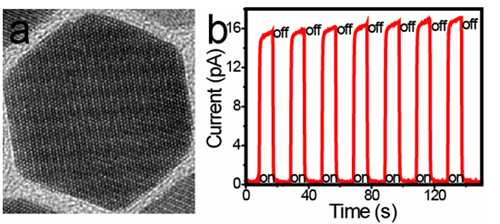Synthesis of Metal Selenide Nanomaterials and Their Application in High-Performance Photodetectors
Metal selenides nanomaterials have attracted particular attention due to their fascinating physical and chemical properties for applications in electronics, photonics and photoelectric. Photodetector as key important element of optoelectronics is important in both photon detection and solar energy conversion.
With the supports of the Chinese Academy of Sciences, the Chinese Ministry of Science and Technology, and the National Natural Science Foundation of China, the researchers in the Chinese Academy of Sciences Key Laboratory of Molecular nanostructure and nanotechnology and Key Laboratory of Organic Solids made a series of progresses in photodetectors based on metal selenide nanomaterials (J. Am. Chem. Soc. 2009, 131, 15602-15603 and J. Am. Chem. Soc. 2010, 132, 12218-12221).
They prepared indium selenide (InSe) nanowires through a vapor transport system without any metal catalysts. A single nanowire deposited between two electrodes produced a low current (40 pA) in the dark, and a current up to 50 times higher (2000 pA) upon visible light irradiation. Switching between the two distinct states was reversible and fast. Most importantly, the photoresponse of the nanowires undegraded after stored in air over two months. The result was highlighted by Nature China (http://www.nature.com/nchina/2009/091028/full/nchina.2009.211.html).
In addition, CuInSe2 is a promising light-absorbing material suitable for high-efficiency solar cells with a appropriate direct band-gap and high absorption coefficient. The reseachers synthesized uniform hexagonal shape and monodispersed CuInSe2 nanocrystals. A high-performance photodetector based on a hybrid film of CuInSe2 nanocrystals and poly(3-hexylthiophene) was constructed. The device showed distinct “ON” (0.15 pA) and “OFF” (17 pA) states with fast and reversible switching responding to outside illumination. The current of the photodetector exhibited a strong dependence on light intensity, indicating superior photocurrent capability of the hybrid material. Furthermore, the hybrid photodectector also showed an outstanding stability and no obvious degradation was observed during extended hundreds of cycles. The high sensitivity and stability of the hybrid device revealed a broad prospect for use of the hybrid material in light detection, signal magnification, and energy conversion.

Figure1. (a) TEM image of CuInSe2 nanocrystal. (b) On/off switching of the hybrid devices. (Image by WANG Jianjun et al.)





